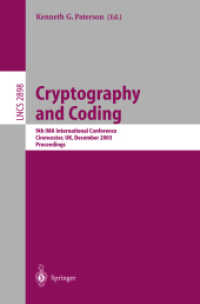- ホーム
- > 洋書
- > 英文書
- > Architecture
Full Description
Ancient American palaces still captivate those who stand before them. Even in their fallen and ruined condition, the palaces project such power that, according to the editors of this new collection, it must have been deliberately drawn into their formal designs, spatial layouts, and choice of locations. Such messages separated palaces from other elite architecture and reinforced the power and privilege of those residing in them. Indeed, as Christie and Sarro write, "the relation between political power and architecture is a pervasive and intriguing theme in the Americas."
Given the variety of cultures, time periods, and geographical locations examined within, the editors of this book have grouped the articles into four sections. The first looks at palaces in cultures where they have not previously been identified, including the Huaca of Moche Site, the Wari of Peru, and Chaco Canyon in the U.S. Southwest. The second section discusses palaces as "stage sets" that express power, such as those found among the Maya, among the Coast Salish of the Pacific Northwest, and at El TajÍn on the Mexican Gulf Coast. The third part of the volume presents cases in which differences in elite residences imply differences in social status, with examples from Pasado de la Amada, the Valley of Oaxaca, Teotihuacan, and the Aztecs. The final section compares architectural strategies between cultures; the models here are FarfÁn, Peru, under both the ChimÚ and the Inka, and the separate states of the Maya and the Inka.
Such scope, and the quality of the scholarship, make Palaces and Power in the Americas a must-have work on the subject.
Contents
Preface and Acknowledgments
Note on Orthography
Introduction (Jessica Joyce Christie)
Part 1. Identification of Palaces
1. Looking for Moche Palaces in the Elite Residences of the Huacas of Moche Site (Claude Chapdelaine)
2. Landscape of Power: A Network of Palaces in Middle Horizon Peru (William H. Isbell)
3. Lords of the Great House: Pueblo Bonito as a Palace (Stephen H. Lekson)
Part 2. Palaces as Active Stage Sets of Political Ideology
4. Sacred and Profane Mountains of the PasiÓn: Contrasting Architectural Paths to Power (Arthur A. Demarest)
5. Political Dimensions of Monumental Residences on the Northwest Coast of North America (Colin Grier)
6. Rising Above: The Elite Acropolis of El TajÍn (Patricia Joan Sarro)
Part 3. Correspondences between Material Aspects of Elite Residences and Social Status
7. The Residence of Power at Paso de la Amada, Mexico (Michael Blake, Richard G. Lesure, Warren D. Hill, Luis Barba, and John E. Clark)
8. When Is a House a Palace? Elite Residences in the Valley of Oaxaca (Sarah B. Barber and Arthur A. Joyce)
9. Rulership and Palaces at Teotihuacan (William T. Sanders and Susan Toby Evans)
10. Antecedents of the Aztec Palace: Palaces and Political Power in Classic and Postclassic Mexico (Susan Toby Evans)
Part 4. Comparison of Palaces across Cultures
11. Elite Residences at FarfÁn: A Comparison of the ChimÚ and Inka Occupations (Carol Mackey)
12. Houses of Political Power among the Ancient Maya and Inka (Jessica Joyce Christie)
Conclusions (William T. Sanders)
Contributors
Index







